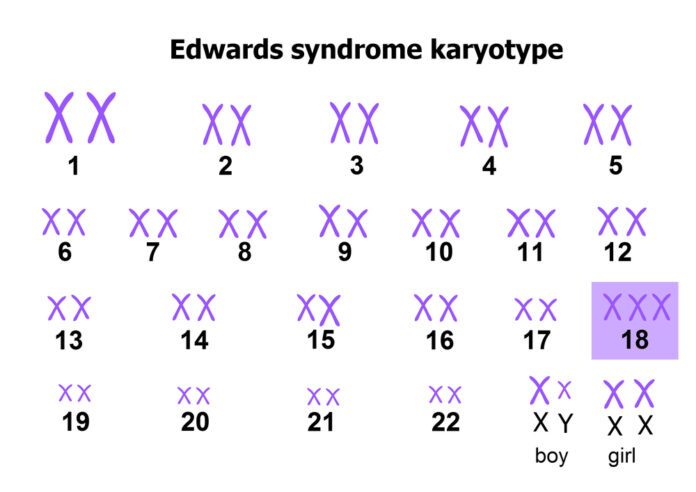Overview Of Trisomy 18 Syndrome
Trisomy 18 syndrome is a genetic disorder in which a person has a third copy of material from chromosome 18, instead of the usual 2 copies. Most cases are not passed down through families. Instead, the problems that lead to this condition occur in either the sperm or the egg that forms the fetus.
Commonly Associated With
Edwards syndrome
Causes Of Trisomy 18 Syndrome
Trisomy 18 occurs in 1 in 6000 live births. It is 3 times more common in girls than boys.
The syndrome occurs when there is extra material from chromosome 18. The extra material affects normal development.
Trisomy 18: the presence of an extra (third) chromosome 18 in all of the cells.
Mosaic trisomy 18: the presence of an extra chromosome 18 in some of the cells.
Partial trisomy 18: the presence of a part of an extra chromosome 18 in the cells.
Most cases of Trisomy 18 are not passed down through families (inherited). Instead, the events that lead to trisomy 18 occur in either the sperm or the egg that forms the fetus.
Symptoms Of Trisomy 18 Syndrome
Symptoms may include:
- Clenched hands
- Crossed legs
- Feet with a rounded bottom (rocker-bottom feet)
- Low birth weight
- Low-set ears
- Mental delay
- Poorly developed fingernails
- Small head (microcephaly)
- Small jaw (micrognathia)
- Undescended testicle
- Unusual shaped chest (pectus carinatum)
Exams & Tests
An exam during pregnancy may show an unusually large uterus and extra amniotic fluid. There may be an unusually small placenta when the baby is born. A physical exam of the infant may show unusual facial features and fingerprint patterns. X-rays may show a short breast bone.
Chromosome studies will show trisomy 18 syndrome. The chromosome abnormality may be present in every cell or present in only a certain percentage of the cells (called mosaicism). Studies may also show part of the chromosome in some cells. Rarely, part of chromosome 18 becomes attached to another chromosome. This is called translocation.
Other signs include:
- Hole, split, or cleft in the iris of the eye (coloboma)
- The separation between the left and right side of the abdominal muscle (diastasis recti)
- Umbilical hernia or inguinal hernia
There are often signs of congenital heart disease, such as:
- Atrial septal defect (ASD)
- Patent ductus arteriosus (PDA)
- Ventricular septal defect (VSD)
Tests may also show kidney problems, including:
- Horseshoe kidney
- Hydronephrosis
- Polycystic kidney
Treatment Of Trisomy 18 Syndrome
There are no specific treatments for trisomy 18. Which treatments are used depend on the person’s individual condition.



